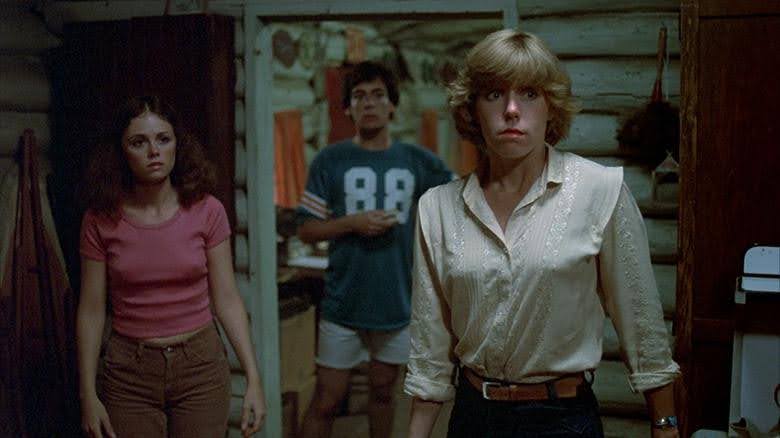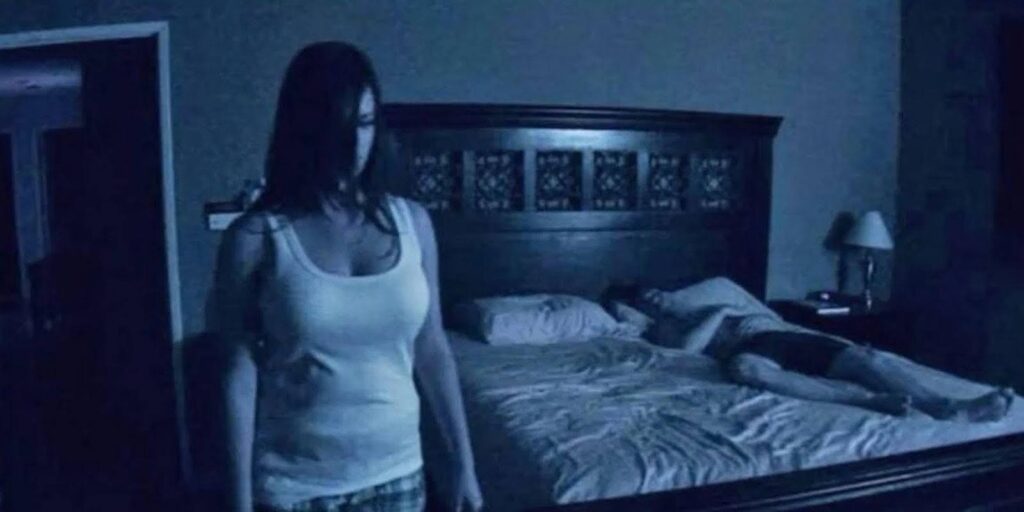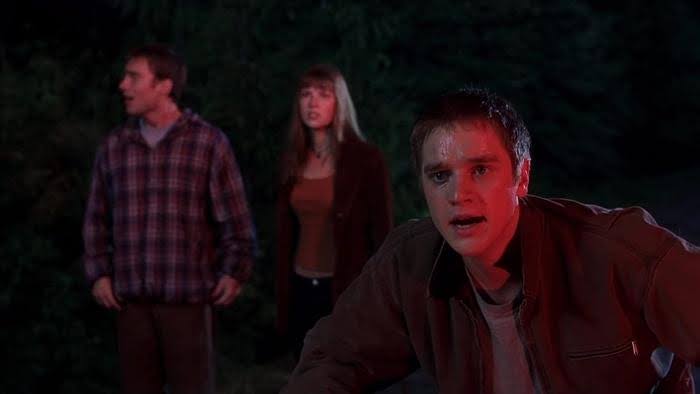
Introduction: the role of flat characters in horror
It takes all sorts to make a world, and the same goes for the characters in our stories. While our rounded characters are usually dynamic, fully rounded, and undergo significant change in the plot, they are usually complemented by flat characters, who are more two-dimensional.
Flat characters have little personality with no internal conflict, a lack of development, and will typically be a stereotype that we’ve seen many times before.
One-dimensional characters play a key role in our stories, helping their rounded counterparts shine. Contrary to popular belief, flat characters aren’t necessarily badly written, they just conform to their original formula and never change.
Horror is known for its stereotypes and flat characters have a lot to do with this. They are a great tool for enhancing fear in our favorite horrors and maintaining focus on the main conflict, keeping us in suspense, or in a sense of terror.
How? Well, we’re about to find out as we dive into flat characters in horror, how they compare to rounded characters. We’ll even throw in some top tips on how to effectively write your own horror flat characters.
But first, why does horror rely on flat characters?
Why horror relies on flat characters
Like all genres, horror has a particular set of conventions or tropes that flat characters serve. It relies on atmosphere, tension and fear, and using flat characters is just one of the ways that horror maximizes this.
By keeping most characters one-dimensional, the story can focus more on building suspense, crafting disturbing environments and pushing the shock value. If there’s too much emphasis on character development, it can detract from the unsettling energy that horror needs.
As horror is focused on our most primal fears, flat characters make it easier to project these fears onto an audience. Too much emotional distance between the characters and the audience can make it difficult for a viewer to feel as though they’re in the same perilous situation as the victim.
Flat characters have also helped create the most famous archetypes in the horror genre, such as the final girl, the monster, or the condemned victim. These archetypes are deep-rooted in our fears and serve to explore broader ideas like good vs. evil, or survival vs. death.
In the slasher and monster horror sub-genres, the sense that anyone could die at anytime is the key thread holding the story together. If we become too emotionally attached to a character and they’re suddenly brutally killed off, their death may require more emotional resolution. By using flat characters that can be easily disposed of with little narrative consequence, horror filmmakers create a more chaotic and unpredictable story world.
Horror narratives usually require a lot to happen in a short space of time, even if we get there through a slow-burn tension or quick escalation. If we used complex characters with intricate backgrounds, the momentum is immediately slowed down. By utilizing flat characters, we keep the story moving and the focus on the protagonist.
Despite their superficial nature, flat characters have a deeper role to play in horror movies, as they can be used to comment on human nature. By reducing characters to their basic traits, such as fear, greed, or lust, we can explore these in the most exaggerated and horrifying ways, without the usual complexities.
Examples of Flat Characters in iconic horror films
Now we know more about the function of flat characters in horror, let’s see them in action!
Friday the 13th (Franchise 1980-Present)
The threat of Jason Voorhees and his mother before him, is the constant antagonistic force in the Friday the 13th franchise. The teens are unaware of the threat until it’s too late, blissfully ignorant to the cat-and-mouse game they’re part of. They are presented as little more than targets for the killer with surface-level traits like ‘jock’ or ‘the shy one’ without any further history.
Alice Hardy is presented as the final girl in the original 1980 movie, and has a little more depth than the other characters. Yes, she lacks a complex backstory, but she is the one the audience follows as she pieces together what’s happening.
As a slasher franchise, Friday the 13th relies on quick emotional payoff and horrific presentations of death, with little room for deep emotions and character development. so the use of flat characters here works perfectly. We focus on the cat-and-mouse game and the horrors that await the characters, their deaths shocking and impactful.

Paranormal Activity (Franchise 2007-2021)
Throughout the Paranormal Activity movies, the characters are intentionally ordinary and doing ordinary things. You could almost interchange them. In short, they could be anyone, and therefore the scares that occur could happen to anyone – including anyone watching.
These flat characters enhance the immersive experience of Paranormal Activity alongside the very ordinary environments the filmmakers set the action in. The paranormal is the focus, rather than the characters. Tension is built through the gradual escalation of paranormal disturbances, rather than through character conflict.
While there is a small amount of conflict, for example, when Katie repeatedly pleads with Micah to stop filming the paranormal occurrences and take things seriously, it isn’t explored further to assert the audience’s attention on the supernatural.

Final Destination (Franchise 2000-Present)
From the first Final Destination movie, the characters are there to showcase the creative ways that death itself can take them. With simple personalities and little backstory, it allows the audience to focus on the suspense and all the possible ways that death will rear its ugly head.
All the characters have simple traits. For example, in the first movie, Alex has the premonition, Carter is hot-headed, and Clear is the mysterious one. We only need these basic personalities in the first place, as we know their fates are all doomed, and instead, we focus on death as the main character and the spectacle of how it carries out its will.
By using such archetypes in our own horror scripts, we can help our audience immerse themselves in the tension and certain horrors that we’ll soon unleash.

Bird Box (2018)
Malorie, the protagonist in Bird Box, is closely defined by her survival instinct, avoiding the reach of the creature, which we never see. There is some emotional depth to her character, such as the refusal to name her children, and her focus on merely surviving. Her character is one of pragmatism, rather than a deep emotional battle.
We know this from her lack of connection on a maternal level with her children, whom she sees as partners in survival. Malorie’s ‘flatness’ adds to the isolation and psychological pressure of a world where the characters cannot see their surroundings. This is the horror of the whole movie and what the audience focuses on.
Due to the characters’ isolation and being in a very small space, they lack emotional awareness and have lost control of their environment, bolstering the fear factor. Bird Box is a prime example of flat characters feeding into the horror.

Don’t look away from your next great horror script.
write it with celtx!
The Cabin in the Woods (2011)
One of our favorite examples of a successful horror movie, The Cabin in the Woods, not only subverts horror tropes, but also uses flat characters effectively to trigger the fear and scares throughout.
They are quintessential horror characters, from the jock, the scholar, the fool and the final girl. By intentionally portraying them all as flat characters, they all had a clear role to play within the narrative. Doing this provided a commentary on the predictability of horror genre conventions.
The cabin itself is the stand-out ‘character’, reacting to the actions of the collective protagonists who trigger the scares inside. Here is where the conflict lies and what draws our attention.
The technicians who rigged the cabin also serve as a parallel narrative, their casual and humorous approach to their task used as social critique for horror conventions. Again, they don’t have complex backstories, but rather act as conduits for the movie’s overall message to horror audiences.

Flat vs. Dynamic in horror
Of course, it’s all about balance, and it is possible to have both flat and more dynamic characters side by side in a horror movie. It depends on the type of horror movie as to how the scales are tipped…
Let’s take a slasher movie. While flat characters such as the ‘jock’ or ‘cheerleader’ serve as easy targets for the killer, with their predicable behavior adding to the tension, the inclusion of more dynamic characters like the protagonist or ‘final girl’ can be beneficial. If they evolve and face their fears at the end of the movie, this can enhance the emotional stakes and push the final pivotal moments to the next level.
For example, in Halloween (1978), Laurie Strode evolves from shy babysitter to a resourceful fighter and the ‘final girl’. We’re with her in her journey from the start and become invested in her character. She is surrounded by typical high schoolers, like the promiscuous girl (Annie) and the innocent girl (Lindsey), who are all easy targets for Michael Myers. The presence of Annie and Lindsey helps build tension and allows Laurie to rise and be the stand-out character.
Did someone say “Final Girl?” Read all about horror tropes and their history in horror films here!
On the flip side, Nina in Black Swan (2010) undergoes a decline in her character. From a confident prima ballerina to psychological breakdown, we see her slowly consumed by her role. Flat characters like her mother and fellow dancers influence the horror we see before us, and only push Nina further into her internal struggle.
There is indeed a danger of using too many flat characters, leaving an audience disinterested and the emotional stakes barely detectable. For example, the entire group of protagonists in The Bye Bye Man (2017) are hugely predictable, with no standout characters to redeem them. There is a huge lack of suspense, making the plot predictable. A similar example is The Gallows (2015), again featuring a group of students with whom we fail to engage.
How to effectively write flat characters for horror
Flat characters are deceptive, a careful balance which can be tricky to master. But never fear, as we have some quick, actionable tips to help you craft solid and impactful flat characters to enhance your next horror script.
They need a clear role
Don’t just add a flat character into your story for the sake of it. Ensure they have specific function, such as comic relief, exposition or embodying a particular fear. This needs to stay consistent throughout the narrative.
They need distinctive traits
While flat characters aren’t deep, they should have a defining feature that sets them apart from their peers. Do they have a unique catchphrase? What mannerisms do they have? What quirks do they have?

They need to react and respond
A flat character’s role is to enhance the story and bolster the dynamic characters. One way to do this is to focus on their interactions and how they highlight and push the protagonist’s growth.
They need to subvert archetypes
Archetypes have been horror’s bread and butter since its dawn. Avoid and challenge chiches where you can – how can you put a spin on them?
It can be helpful to list all your flat characters and briefly outline their role and what they’re going to do to drive the plot. Simple character templates can help.
More comprehensive outlining tools are also perfect for this. Beat sheets can help define your characters’ actions in particular moments in the story, while storyboards help visualize what you’ve written on the page. Check out our whole suite of resources here.
While you’re here, why not check out our thorough guide on writing your own horror movies: From Dreams to Screams: How to Write a Horror Script?
Closing: Crafting the perfect balancer
Achieving a balance between flat and dynamic characters is crucial in crafting effective horror scripts. Flat characters can amplify tension and highlight the protagonist’s journey, while dynamic characters provide depth and emotional stakes.
As you develop your own horror stories, evaluate your character choices to ensure they serve the story purposefully and consider how they contribute to the atmosphere and themes. By thoughtfully blending these types, you can create a more engaging and impactful horror experience and give audiences the scare of their lives. Happy writing!
Loved this blog? Try these next!
- Defining Stock Characters: Their Role & Classic Examples
- Character Foil: The Secret Ingredient for Dynamic Duos in Screenwriting
- Horror Tropes We Love—and the Ones We Need to Bury


